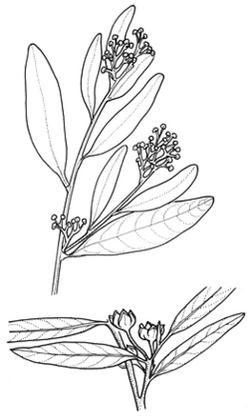
Description: Dioecious or monoecious shrubs or small trees.
Leaves alternate, entire, often viscid, flat or margins recurved, pale or white-tomentose on lower surface; ± sessile; stipules absent.
Flowers axillary, the males often clustered on recurved peduncles; females solitary. Sepals usually 5, broad, often petaloid. Petals sometimes absent. Male flowers with numerous stamens, filaments short, crowded on a hemispherical receptacle. Female flowers with sepals thicker and narrower than in males; ovary 3-lobed; stigma sessile, entire or 2-lobed.
Capsule ovoid, 1–3-seeded, on an erect, angular peduncle widened under fruit; seeds oblong, smooth, shining, carunculate.
Distribution and occurrence: World: 15 species, endemic Australia. Australia: all States.
Text by T. A. James & G. J. Harden
Taxon concept:
| | Key to the species | |
| 1 | Ovaries and fruits densely hairy, non-resinous | Beyeria lasiocarpa |
| Ovaries and fruits glabrous or with a few scattered hairs, usually resinous | 2 |
| 2 | Abaxial surface of leaf blades densely and minutely tomentose with crispate hairs > 0.1 mm long, never resinous. | Beyeria lechenaultii |
| Abaxial surface of leaf blades glabrous or densely puberulous with hairs <0.1 mm long, often obscured by resinous covering
Back to 1 | 3 |
| 3 | Leaf blades lanceolate; fruits 10–12 mm long. | Beyeria lanceolata |
| Leaf blades narrow-elliptic to elliptic or narrow-obovate; fruits 5–9 mm long.
Back to 2 | 4 |
| 4 | Leaf blades narrow-obovate, 7–20 mm long, < 5 mm wide; ovaries 2-locular. | Beyeria opaca |
| Leaf blades narrow-elliptic to elliptic or narrow-obovate to obovate, 20–90 mm long, 5–30 mm wide; ovaries 3-locular.
Back to 3 | Beyeria viscosa |
|


